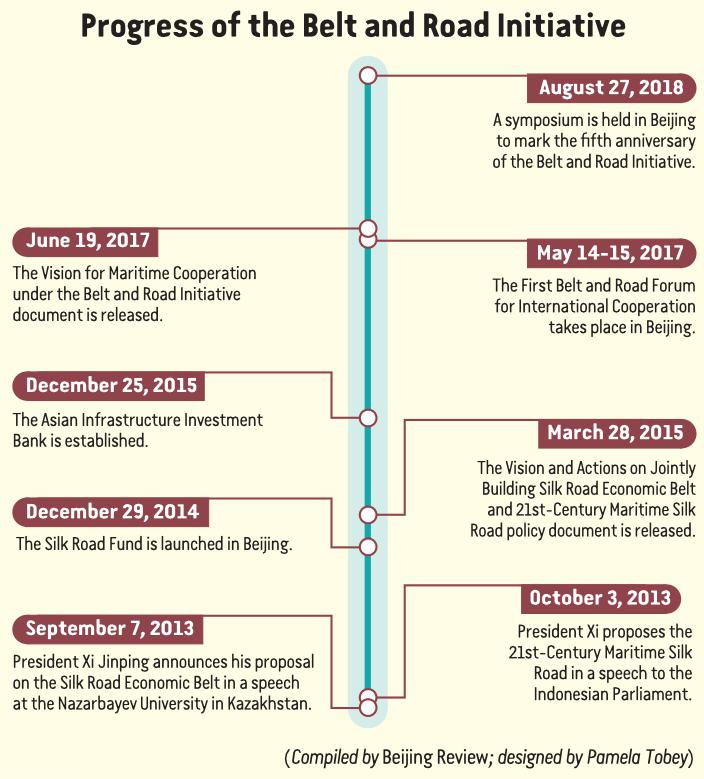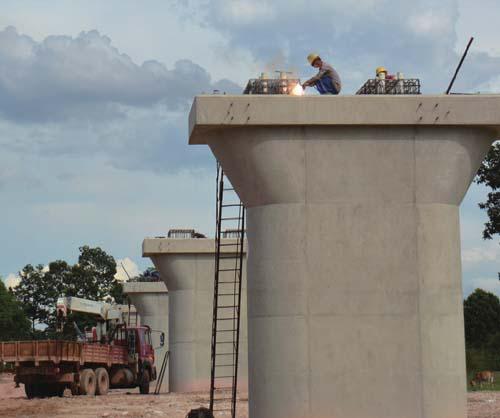BELT AND ROAD LIFTS OFF
2018-10-21ByZhaoLei
By Zhao Lei
The international cooperation based on the Belt and Road Initiative has made great strides since it was fi rst conceived fi ve years ago.
The initiative, which aims to promote common development, has won wide recognition from the international community. To date, China has signed cooperation deals with more than 100 countries and regions as well as international organizations to jointly advance the Belt and Road Initiative. The core ideas of the initiative have also been accepted and written into the final documents of many important international organizations and institutions including the UN, the G20, the Asia-Pacifi c Economic Cooperation and the Shanghai Cooperation Organization.
Along with its broad acknowledgment in the world arena, the initiative is also becoming key to Chinas taking part in global governance and promoting the building of a community with a shared future for mankind.
A new type of public good
Traditional globalization is often referred to as modernization dominated by the West in the world systems theory, but the target of the Belt and Road Initiative is to build a world of common modernization. The world systems theory was fi rst put forward by U.S. sociologist Immanuel Wallerstein, who considered integration and inequality the two most important features in the capitalist world economic sys- tem. In his theory, global division of labor and world commodity exchange relations are the two major factors that bind all members of the international community fi rmly into a huge net that is the world economy. However, integration does not automatically lead to equalization.
The world economy is still a hierarchical structure consisting of the core, semi-periphery and periphery. Developed countries such as the UK, the United States and Japan are at the core of the system. Some moderately developed countries are on the semi-periphery of the system and a large number of developing countries in Asia, Africa and Latin America, and even some Eastern European countries, are on its periphery. With their superior position, those countries at the core can take advantage of the rest of the countries in both production and exchange.
The Belt and Road Initiative stands for a new type of globalization. With a basic logic of decentralization, it advocates common, fair and inclusive development. Therefore, the initiative is essentially opposed to colonialism, imperialism and hegemonism. In the past five years, the construction of Belt and Road projects demonstrated a notice- able feature: most projects were built in peripheral or semi-peripheral countries, such as the five Central Asian countries and the 16 Central and Eastern European countries. Many of these countries are landlocked nations, like Laos, Ethiopia, the Czech Republic and Kazakhstan. They enjoy few benefits from globalization mostly due to their geographical position. The Belt and Road Initiative, which promotes policy coordination and facilitates connectivity, unimpeded trade, financial integration and people-to-people bonds, can help transform these landlocked nations into land-linked countries, making them indispensable nodes in the globaliza- tion grid, which fully embodies the global governance principles of achieving shared growth through discussion and collaboration. The initiative is an excellent example of public goods provided by China to promote world development.
Expanding cooperation
Since the beginning of the year, unsavory comments about the Belt and Road Initiative have been increasing. In contrast to five years ago when critics accused China of exporting excess capacity and competing with the United States for geopolitical supremacy, negative narratives now focus on alleged violation of international rules and debt-trap diplomacy by China.
While none of these accusations are well grounded, China needs to readjust its approach as it continues to advance the Belt and Road Initiative.
Many Chinese companies engage in capital-intensive projects overseas such as the Gwadar Port, the Bangladesh-ChinaIndia-Myanmar Economic Corridor and the China-Belarus Industrial Park. But infrastructure construction is only part of the story. It is equally crucial for China to invest more in sectors such as education, medical care and agriculture so that the Belt and Road Initiative can benefit local people in a more tangible way.
Furthermore, it is unfair that Chinas performance is too often judged by only Western research institutes. China needs to conduct more quantitative research into the Belt and Road Initiative based on its own indexes. With inclusiveness serving as one of its most essential traits, the initiative is open to different opinions. It is ill-advised either to exaggerate its importance or to reject its achievements.
In addition to research and consultation, it is imperative that China offer premium financial services. For example, in Africa, insufficient funds have long been a bottleneck constraining development on the continent. China can be a reliable partner as it takes a long view. Chinas investment goals are to help African countries promote indigenous industries so that they can sustain their development. After building roads, ports and power plants, Chinese companies should work to enhance local production capacity. Products can not only meet domestic demand but can also be exported to earn foreign exchange. Institutions that finance this development should be results-oriented and transparent.
Focused on the future
At a symposium marking the fifth anniversary of the Belt and Road Initiative on August 27, President Xi Jinping called for efforts to push for progress in projects that deliver real benefits to local people, and to keep expanding the market while maintaining trade balance.
He advocated a policy system of financial support for the initiative and encouraged non-governmental fund sources to invest in infrastructure and resource development projects in Belt and Road countries.
Xi pointed out that jointly pursuing the Belt and Road Initiative was not only aimed at economic cooperation, but also an important pathway to improve global development patterns and global governance and to promote the healthy development of economic globalization.
Indeed, the Belt and Road Initiative is intended to provide badly needed support to countries along and beyond the ancient Silk Road routes. China, a developing nation that suffered from backwardness and dire poverty in the past, fully understands the concerns of its partners. It will never attempt to subordinate others, but will always seek win-win outcomes, a value that is in the DNA of the Chinese people.
